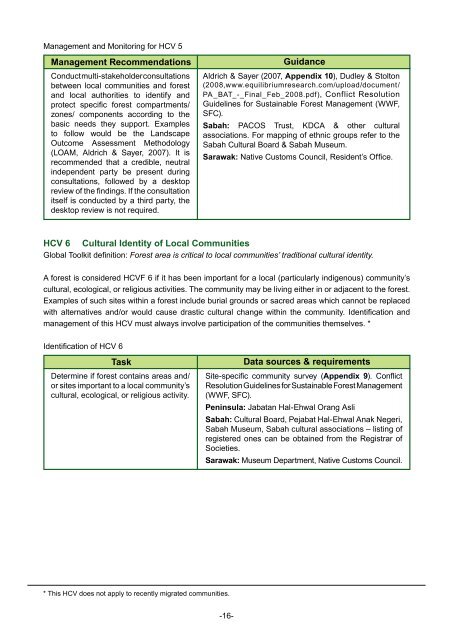(HCVF) Toolkit for Malaysia - HCV Resource Network
(HCVF) Toolkit for Malaysia - HCV Resource Network
(HCVF) Toolkit for Malaysia - HCV Resource Network
Create successful ePaper yourself
Turn your PDF publications into a flip-book with our unique Google optimized e-Paper software.
Management and Monitoring <strong>for</strong> <strong>HCV</strong> 5<br />
Management Recommendations<br />
Conduct multi-stakeholder consultations<br />
between local communities and <strong>for</strong>est<br />
and local authorities to identify and<br />
protect specific <strong>for</strong>est compartments/<br />
zones/ components according to the<br />
basic needs they support. Examples<br />
to follow would be the Landscape<br />
Outcome Assessment Methodology<br />
(LOAM, Aldrich & Sayer, 2007). It is<br />
recommended that a credible, neutral<br />
independent party be present during<br />
consultations, followed by a desktop<br />
review of the findings. If the consultation<br />
itself is conducted by a third party, the<br />
desktop review is not required.<br />
Guidance<br />
Aldrich & Sayer (2007, Appendix 10), Dudley & Stolton<br />
(2008,www.equilibriumresearch.com/upload/document/<br />
PA_BAT_-_Final_Feb_2008.pdf), Conflict Resolution<br />
Guidelines <strong>for</strong> Sustainable Forest Management (WWF,<br />
SFC).<br />
Sabah: PACOS Trust, KDCA & other cultural<br />
associations. For mapping of ethnic groups refer to the<br />
Sabah Cultural Board & Sabah Museum.<br />
Sarawak: Native Customs Council, Resident’s Office.<br />
<strong>HCV</strong> 6 Cultural Identity of Local Communities<br />
Global <strong>Toolkit</strong> definition: Forest area is critical to local communities’ traditional cultural identity.<br />
A <strong>for</strong>est is considered <strong><strong>HCV</strong>F</strong> 6 if it has been important <strong>for</strong> a local (particularly indigenous) community’s<br />
cultural, ecological, or religious activities. The community may be living either in or adjacent to the <strong>for</strong>est.<br />
Examples of such sites within a <strong>for</strong>est include burial grounds or sacred areas which cannot be replaced<br />
with alternatives and/or would cause drastic cultural change within the community. Identification and<br />
management of this <strong>HCV</strong> must always involve participation of the communities themselves. *<br />
Identification of <strong>HCV</strong> 6<br />
Task<br />
Determine if <strong>for</strong>est contains areas and/<br />
or sites important to a local community’s<br />
cultural, ecological, or religious activity.<br />
Data sources & requirements<br />
Site-specific community survey (Appendix 9). Conflict<br />
Resolution Guidelines <strong>for</strong> Sustainable Forest Management<br />
(WWF, SFC).<br />
Peninsula: Jabatan Hal-Ehwal Orang Asli<br />
Sabah: Cultural Board, Pejabat Hal-Ehwal Anak Negeri,<br />
Sabah Museum, Sabah cultural associations – listing of<br />
registered ones can be obtained from the Registrar of<br />
Societies.<br />
Sarawak: Museum Department, Native Customs Council.<br />
* This <strong>HCV</strong> does not apply to recently migrated communities.<br />
-16-

















